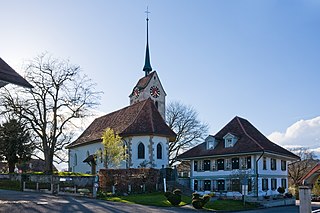
Lovatens is a municipality in the district Broye-Vully in the canton of Vaud in Switzerland.

Champtauroz is a municipality in the district of Broye-Vully in the canton of Vaud in Switzerland.

Oberwil bei Büren is a municipality in the Seeland administrative district in the canton of Bern in Switzerland.
Aetigkofen is a former municipality in the district of Bucheggberg in the canton of Solothurn in Switzerland. On 1 January 2014 the former municipalities of Aetigkofen, Tscheppach, Brügglen, Aetingen, Bibern (SO), Gossliwil, Hessigkofen, Mühledorf (SO), Küttigkofen, Kyburg-Buchegg merged into the new municipality of Buchegg.

Balm bei Messen was a municipality in the district of Bucheggberg in the canton of Solothurn in Switzerland. On 1 January 2010 the municipalities of Balm bei Messen, Brunnenthal and Oberramsern merged into the municipality of Messen.
Biezwil is a municipality in the district of Bucheggberg, in the canton of Solothurn, Switzerland.
Brügglen is a former municipality in the district of Bucheggberg, in the canton of Solothurn, Switzerland. On 1 January 2014 the former municipalities of Brügglen, Tscheppach, Aetingen, Aetigkofen, Bibern (SO), Gossliwil, Hessigkofen, Mühledorf (SO), Küttigkofen, Kyburg-Buchegg merged into the new municipality of Buchegg.

Brunnenthal was a municipality in the district of Bucheggberg, in the canton of Solothurn, Switzerland. On 1 January 2010 the municipalities of Balm bei Messen, Brunnenthal and Oberramsern merged into the municipality of Messen.
Gossliwil is a former municipality in the district of Bucheggberg, in the canton of Solothurn, Switzerland. On 1 January 2014 the former municipalities of Gossliwil, Tscheppach, Brügglen, Aetingen, Aetigkofen, Bibern (SO), Hessigkofen, Mühledorf (SO), Küttigkofen, Kyburg-Buchegg merged into the new municipality of Buchegg.

Küttigkofen is a former municipality in the district of Bucheggberg, in the canton of Solothurn, Switzerland. On 1 January 2014 the former municipalities of Küttigkofen, Tscheppach, Brügglen, Aetingen, Aetigkofen, Bibern (SO), Gossliwil, Hessigkofen, Mühledorf (SO), Kyburg-Buchegg merged into the new municipality of Buchegg.

Lüsslingen is a former municipality in the district of Bucheggberg, in the canton of Solothurn, Switzerland. On 1 January 2013, Lüsslingen and Nennigkofen merged to form Lüsslingen-Nennigkofen.

Lüterkofen-Ichertswil is a municipality in the district of Bucheggberg, in the canton of Solothurn, Switzerland. It was formed in 1961 from the merger of the two previously independent municipalities of Lüterkofen and Ichertswil.

Lüterswil-Gächliwil is a former municipality in the district of Bucheggberg, in the canton of Solothurn, Switzerland. It was formed in 1994 from the merger of the two previously independent municipalities of Lüterswil and Gächliwil. On 1 January 2024 the former municipality of Lüterswil-Gächliwil merged into the municipality of Buchegg.

Messen is a municipality in the district of Bucheggberg, in the canton of Solothurn, Switzerland. On 1 January 2010 the municipalities of Balm bei Messen, Brunnenthal and Oberramsern merged into the municipality of Messen.

Mühledorf is a former municipality in the Bucheggberg District, in the canton of Solothurn, Switzerland. On 1 January 2014 the former municipalities of Mühledorf (SO), Tscheppach, Brügglen, Aetingen, Aetigkofen, Bibern (SO), Gossliwil, Hessigkofen, Küttigkofen, Kyburg-Buchegg merged into the new municipality of Buchegg.

Nennigkofen is a former municipality in the district of Bucheggberg, in the canton of Solothurn, Switzerland. On 1 January 2013, Lüsslingen and Nennigkofen merged to form Lüsslingen-Nennigkofen.

Unterramsern is a municipality in the district of Bucheggberg, in the canton of Solothurn, Switzerland.
Lohn-Ammannsegg is a municipality in the district of Wasseramt in the canton of Solothurn in Switzerland. The municipality was formed in 1993 when Lohn and Ammannsegg united.

Bucheggberg District is one of the ten districts of the canton of Solothurn in Switzerland, situated to the southwest of the canton. Together with the Wasseramt District, it forms the Amtei of Wasseramt-Bucheggberg. It has a population of 8,009.

Anwil is a municipality in the district of Sissach in the canton of Basel-Country in Switzerland.



















